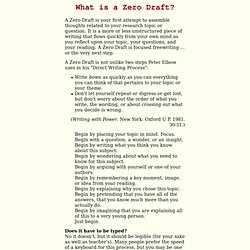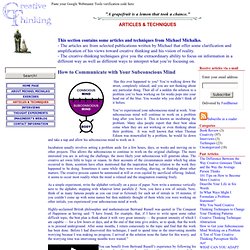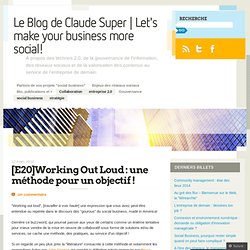

Brainwriting (méthode 635) Zero Draft. A Zero Draft is your first attempt to assemble thoughts related to your research topic or question.

It is a more or less unstructured piece of writing that flows quickly from your own mind as you reflect upon your topic, your questions, and your reading. A Zero Draft is focused freewriting ... or the very next step. A Zero Draft is not unlike two steps Peter Elbow uses in his "Direct Writing Process": Freewrite. Edit Article.

5 Techniques for Fighting Writer's Block. Kevin Lee | September 12, 2014 | Comments Even the best writers battle writer's block from time to time, and when you're writing about a niche subject, coming up with new ideas can be hard.

Here are five tips for how to get the ideas flowing. Writer's block is a deadly malaise that can shut down even the best-laid content marketing plans. It happens because writers aren't machines (even machines need a rest once in awhile). Since content is king across SEO and social media, as well as in traditional publishing and print newsletters, a steady stream of relevant, interesting, and engaging content is often expected from the writers on a marketing team of agency. The result is an increasingly erratic flow of tired, listless content that's agonizing to read (if it's even read at all).
Short of rest (hard to come by in today's relentless, 24/7 content-driven economy), I've found the following techniques to be effective in warding off writers' block and content marketing burnout: 1. 2. 3. 4. 5. Inspirational Quotes. Random Entry (or Random Input) Edward de Bono's Lateral Thinking tool, Random Entry, uses a randomly chosen word, picture, sound, or other stimulus to open new lines of thinking.

This tool plays into the power of the human mind to find connections between seemingly unrelated things. First, the person or group lists all the alternatives that they can think of without using the tool, Then they select a random word or other random stimulus. Then they juxtapose the stimulus alongside the focus topic and generate ideas to connect the two. Random Entry Example: The training division of a large IT company wants its trainees to feel at home while they spend several weeks at an off-site learning center. The training team lists alternatives and then chooses a picture at random from a pile of photos to use as a stimulus for more ideas.
Teapots are rounded. Random Entry is one of the easier tools to use with untrained groups, so long as the leader knows what he or she is doing.
Ideas Storming. Ideation Techniques Templates. Creative Thinking Articles and Techniques by Michael Michalko » Blog Archive » How to Communicate with Your Subconscious Mind. Has this ever happened to you?

You’re walking down the street, completely relaxed, and you are not thinking about any particular thing. Then all of a sudden the solution to a problem you’ve been working on for weeks pops into your head out of the blue. You wonder why you didn’t think of it before. ReFrame – helps you to think differently. Here's Why, How, And What You Should Doodle To Boost Your Memory And Creativity.
Did your boss ever catch you covering an important memo with Escher-like scribbles?

In high school, did your teacher call you out for drawing on the desk, your sneakers, your skin? Today, the doodle nay-sayers are being drowned out by a growing body of research and opinion that indicates that connects that seemingly distracted scribbling with greater info retention and creativity. Companies like Dell, and Zappos, and Disney are eager for employees to doodle on the job—they even pay consultants to help them. "I can’t tell you how important it is to draw," says Sunni Brown, whose creative consultancy Sunni Brown Ink, teaches "applied visual thinking"— a.k.a doodling—to coders, designers, and even journalists. "It gets the neurons to fire and expands the mind. " Why Doodle Studies have shown that doodling can free up short- and long-term memory, improve content retention and increase attention span.
Creative Breaks. La méthode Working Out Loud. "Working out loud", [travailler à voix haute] une expression que vous avez peut-être entendue ou repérée dans le discours des "gourous" du social business, made in America!

Derrière ce buzzword, qui pourrait passer aux yeux de certains comme un énième tentative pour mieux vendre de la mise en oeuvre de collaboratif sous forme de solutions et/ou de services, se cache une méthode, des pratiques, au service d’un objectif ! Si on regarde un peu plus près la "littérature" consacrée à cette méthode et notamment les propositions faites par John Stepper qui enrichit la définition initiale proposée par Bryce William, à savoir : Assumption Busting Technique. Edison's Idea File. One of the great "idea-relaters" was Thomas Edison.

Edison, like other great minds, kept track of good ideas, either his own or those generated by others. He maintained extensive idea files to stimulate new perspectives for his current projects. Edison felt strongly that an idea needs to be original only in its adaptation to your problem.Mark Twain once replied to an interviewer "All ideas are second hand, consciously or unconsciously drawn from a million outside sources and used by the creative person with pride and satisfaction. "A creative mind recognizes, perhaps on an unconscious level as Twain suggests, the essential merits and attribute of a good idea and can adapt these elements to other applications thereby "creating" a new idea.Record ideas on note cards and store them in a file box.
In the event you need further information about an idea, indicate the source where you found the idea. Select the ideas that contain attributes closely related to the attributes of your subject.